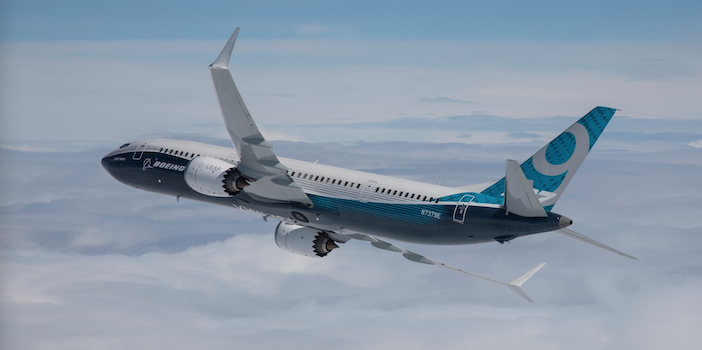On 6th January 2024, an Alaska Airlines Boeing 737 MAX 9 aircraft experienced a mid-flight emergency landing after a section of the fuselage, approximately the size of a refrigerator, blew off shortly after takeoff from Portland, Oregon. The incident, which occurred at an altitude of around 16,000 feet, is again raising concerns about the safety of the 737 Max family of aircraft.
Background and investigation
The incident on board Alaska Airlines Flight 1282, carrying 177 passengers and crew, is the latest in a series of problems that have plagued the 737 MAX since its return to service in 2020 following a two-year grounding due to two fatal crashes. The cause of the fuselage rupture remains under investigation by the National Transportation Safety Board (NTSB). However, early indications suggest that the issue may be related to the manufacturing process or the installation of the fuselage plug.
Preliminary reports indicate that in the weeks leading up to the incident, Alaska Airlines’ pilots had reported pressurisation warnings on three separate flights. While these warnings were initially categorised as “benign,” the connection to the door plug failure remains unclear.
The Alaska Airlines incident has reignited concerns about the quality control measures implemented by Boeing and its suppliers. It also raises questions about the durability of the 737 MAX’s fuselage, particularly in areas where there are gaps or openings. These concerns are particularly worrying given the 737 MAX’s history of safety issues, which have eroded public confidence in the aircraft.
In the case of the Alaska Airlines 737 MAX 9 incident, the fuselage plug that blew off was manufactured by Spirit AeroSystems. The plug is a relatively small part, but it is critical to the integrity of the fuselage.
Potential problems and concerns
Wichita, Kansas-located Spirit AeroSystems manufactures a wide variety of fuselage parts for Boeing aircraft, including doors, windows, bulkheads and floor panels. Boeing and Spirit AeroSystems have a long-standing relationship, and the two companies work closely together to ensure the quality and reliability of the fuselage parts that Spirit AeroSystems supplies.
Yet, last April, Boeing issued a warning about potential delays in the production and delivery of a substantial quantity of its 737 MAX aircraft. The concerns stemmed from uncertainties surrounding Spirit AeroSystems’ efforts in constructing the fuselages. It was related to the setback in Boeing’s plan to deliver 400 to 450 MAX jets last year, which, in turn, was attributed to a flaw involving elongated fastener holes discovered in some components.
Historically, Spirit was a part of Boeing, responsible for manufacturing and assembling a significant number of its aircraft fuselages. In 2005, Spirit AeroSystems was spun off from Boeing as a standalone company, and since then American planemaker has been its biggest customer, accounting for approximately two-thirds of Spirit’s sales. Today, Spirit also produces fuselage sections and front wing spars for the Airbus A350, as well as parts for the fuselages of Bombardier planes. As of Spirit’s latest financial disclosure, roughly 20% of its sales come from Airbus.
The recent production delays and quality issues with the 737 MAX fuselage parts could potentially affect even the relationship between Spirit AeroSystems and Airbus, as well as other major aircraft manufacturers. This is because the issue could lead to further production delays, and quality concerns, which could make planemakers reconsider its reliance on Spirit for fuselage components.

Outlook and what to expect next
If Airbus or Boeing decide to diversify their supply chains and seek other suppliers for fuselage components, it could reduce Spirit’s overall revenue and profit margins. On the other hand, if planemakers would be still satisfied with Spirit’s ability to address the current issues and maintain a high level of quality, then the relationship between the companies could remain strong.
Of course, in the nearest future, the manufacturers will have to continue to rely on Spirit for a significant portion of its fuselage needs, and Spirit could secure a steady source of revenue from Boeing, Airbus, and smaller producers. The outcome of this situation will depend on how effectively Spirit resolves the existing issues and demonstrates its responsibility when it comes to the quality of its assembly.
The NTSB’s investigation is ongoing, and it could even take up to several months to determine the root cause of the fuselage rupture. In the meantime, airlines are grounding their Boeing 737 MAX 9 aircraft until further inspections are completed. The grounding is likely to cause significant disruption to airlines that operate the 737 MAX 9, particularly Alaska Airlines and United Airlines, which are the two largest operators of the aircraft in the United States.
Being the main and largest operator of the 737 MAX 9 with the configuration in question, where such door is plugged, or permanently shut, as opposed to actively used in more densely arranged seating, United currently has 79 such planes, which is significantly more than the 65 operated by Alaska Airlines, or the combined total of 52 of Aeroméxico, Copa Airlines, and Icelandair.
Initially, the FAA indicated that the necessary inspections would require four to eight hours of work [per aircraft], fostering industry expectations of a swift return to service for the planes. However, specific criteria for the checks are still pending agreement between the FAA and Boeing, resulting in a possible delay in providing airlines with detailed instructions.
Implications for Boeing and the aviation industry
The Alaska Airlines incident is a major setback for Boeing, which is still struggling to regain its credibility following the previous 737 MAX crisis. The incident could further damage the company’s reputation and erode customer confidence in its products. It could also lead to regulatory scrutiny.
The incident could also bring closer the possible implementation of the long-demanded extension for the capacity of the 737’s cockpit voice recorders. The US-operated 737 MAX has a two-hour CVR capacity, while the current International Civil Aviation Organization (ICAO) and European Union Aviation Safety Agency (EASA) regulations already demand a capacity of 25 hours, so airlines, operating under the authority of FAA, face serious issues when it comes to investigations of incidents such as this.
Namely, the circuit breaker for the CVR was not deactivated following the incident to safeguard the recording. Consequently, when accessed later, the recording had already been entirely overwritten. Yet, this time again, NTSB Chair Jennifer Homendy advocated for increasing the mandated capacity from the current 2 hours, to 25 hours, on both new and existing aircraft.
For the aviation industry as a whole, the incident serves as a reminder of the importance of rigorous safety standards and thorough inspections. It also highlights the need for open communication, quality control, and more transparency between manufacturers, airlines and regulators.
The Alaska Airlines 737 MAX 9 incident is a serious reminder of the potential risks associated with aviation safety. The investigation into the cause of the fuselage rupture is crucial to understanding the underlying issues and preventing similar incidents from happening in the future. As the investigation progresses, it is important to remain alert and ensure that all necessary steps are taken to ensure the safety of all aircraft operations.
About Locatory.com
Toma Matutyte is CEO of Locatory.com, a global aerospace marketplace covering all aviation-related business needs, with AI-powered tools that benefit aviation part and repair service purchasing. With a wide range of aircraft parts, assets, equipment and repair services, it caters to commercial, OEM, MRO, military, and general aviation segments. The platform has over 20,000 users, experiencing a monthly growth rate of 20% for new customers. Distributors, traders and MRO professionals make up 71% of its user base. Locatory.com is part of the Avia Solutions Group family, the world’s largest ACMI (Aircraft, Crew, Maintenance, and Insurance) provider, with a fleet of 199 aircraft. The group also provides a range of aviation services including, MRO (Maintenance, Repair, and Overhaul), pilot and crew training, ground handling, as well as a variety of associated services. Supported by 11,700 skilled aviation professionals, the group operates in 68 countries worldwide.





